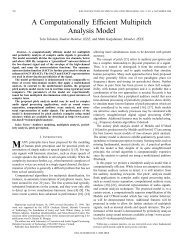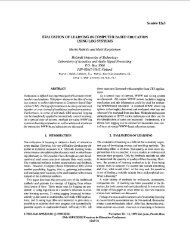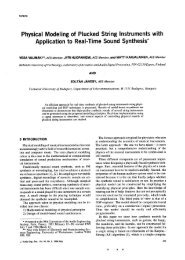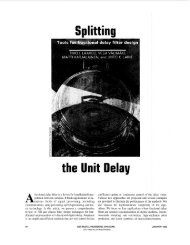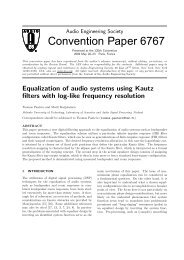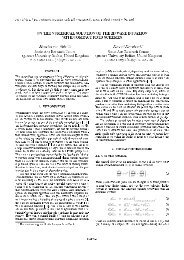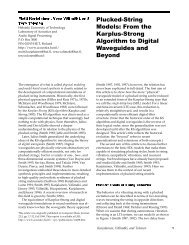DSP Formulation of a Finite Difference Method for Room Acoustics ...
DSP Formulation of a Finite Difference Method for Room Acoustics ...
DSP Formulation of a Finite Difference Method for Room Acoustics ...
Create successful ePaper yourself
Turn your PDF publications into a flip-book with our unique Google optimized e-Paper software.
posite end one time step be<strong>for</strong>e. This can be expressed asthe equation+p iz – 1 -= p i,opp(3)-where p i,opppresents output at opposite end <strong>of</strong> thewaveguide i. By using equations (1) and (3) the soundpressure in a node takes the following <strong>for</strong>mNz – 1Np i,oppz – 1 +p i, opp2 ∑ ------------------------ 2Z∑ ------------------------iZpi = 1i= --------------------------------------- – ---------------------------------------i = 1(4)NN11∑ ----Z∑ ----iZi = 1i = 1 iBy applying once again the same equations we get an expression<strong>for</strong> sound pressureN p iopp ,2 ∑ ---------------p z – 1 Zi = 1 i= ------------------------------ – z – 2 p(5)N1∑ ----Zi = 1 iEquation (5) can be expressed also in <strong>for</strong>m <strong>of</strong> a transferfunctionz – 1 N p Ni, opp 1⋅ 2 ∑ --------------- ⁄Z∑ ----iZpi = 1i= ----------------------------------------------------------------i = 1(6)1 + z – 2In a usual case the medium is homogenous and impedancesin all waveguides are equal and equation (6) can bereduced to the <strong>for</strong>mz – 1 2 N⋅ --- N∑ p i,oppp = ---------------------------------------------i = 1(7)1 + z – 2Verbal description <strong>of</strong> equation (7) is that the sound pressurein a node is two times the average <strong>of</strong> its neighborssubtracted by its own value two time units ago. This expressionis independent <strong>of</strong> the dimensionality <strong>of</strong> the system.Only the number <strong>of</strong> neighbors is relevant.2.2. Mesh ExcitationExciting the mesh must be done so that none <strong>of</strong> the equations(1)-(5) is violated. If we want to create an excitation<strong>of</strong> value I in a homogenous mesh at a node with N neighbors,we set the incoming sound pressure to allwaveguides connected to it. Using equation (2) the value<strong>for</strong> sound pressure is found to be+ Ip i= -- ∀i= 1…N(8)2To keep the equation (3) satisfied the history <strong>of</strong> neighborshas to be updated also, since the outgoing sound pressuresin opposite ends <strong>of</strong> waveguides at one time stepbe<strong>for</strong>e excitation must equal to I/2. Because there are noother outputs, the sum <strong>of</strong> output signals is also I/2, which1D3D2DFig 2. Example structures <strong>of</strong> rectilinear 1D, 2D and 3Dmeshes.is the same as the sum <strong>of</strong> input signals. By using equation(2) again we come to the result that all the neighbor nodesmust have value I/N at one time step be<strong>for</strong>e excitation.3. MESH STRUCTUREThere are different topologies which may be used to constructa digital waveguide mesh. The only restriction isthat all the delay-elements connecting nodes must be <strong>of</strong>equal length. If there are waveguides <strong>of</strong> different lengths,the equation (5) is no more valid. Instead, equation (4) canbe used, z – 1– xis replaced with z i, and x represents the delaylength <strong>of</strong> waveguide i.The requirement <strong>of</strong> equal length waveguides is satisfiedby any regular space decomposition method. It meansthat the atomic tiles <strong>of</strong> decomposition are polytopeswhose sides are <strong>of</strong> equal length [6]. In this study we concentrateon rectilinear meshes, since they are computationallyefficient and easy to construct. Some hexagonal,triangular and tetrahedral structures both in 2- and 3-dimensionalsystems are presented in [7] and [8].An N-dimensional rectilinear waveguide mesh is aregular array <strong>of</strong> digital 1-D waveguides arranged alongeach perpendicular dimension, interconnected at theircrossings. In figure 2 there are examples <strong>of</strong> meshes <strong>of</strong> differentdimensionalities.In an N-dimensional rectilinear mesh each node insidethe mesh has exactly 2*N neighbors. Nodes on the boundarieshave only one neighbor. Due to this arrangement theboundaries can be terminated the same way as in digital1D waveguides.3.1. Sampling Frequency <strong>of</strong> a Rectilinear MeshDistance between mesh nodes together with the mesh topologydetermines the sampling rate <strong>of</strong> the mesh. In a onedimensionalsystem waves propagate one unit distance inone time unit since the waveguide mesh is constructed <strong>of</strong>unit-delays.In a multi-dimensional rectilinear mesh effective wavepropagation speed is found at the diagonal direction. In anN-dimensional system one diagonal movement, correspondingto distance <strong>of</strong> N unit distances, requires N unitdelays. Thus the update frequency <strong>of</strong> a rectilinear N-dimensionalmesh is






